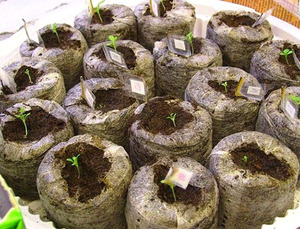Fruit bearing shrubs for the garden. Rare culture
For the first time I read about this unusual apricot with I. V. Michurin. He grew one of his varieties Shlor Tsiran (mistakenly read by him as Tlor Tsiran) under a light cover in a dirt shed. Evaluating the taste of black apricot fruit, the scientist wrote that when used fresh, they “cannot bear comparison with the best varieties of real apricots, but nevertheless, when compared with the fruits of imported common varieties found in our markets, many of those who dislike unleavened the taste of the latter, will willingly give preference to the fruits of black apricot, which have a special piquant sharpness in taste. As for apricot preserves, all of them, without exception, will be on the side of black apricot, because preserves from its fruits, both in appearance and taste, are immeasurably higher in quality than all other apricot varieties. ”
In the opinion of I. V. Michurin, the Shlor Tsiran variety itself is not suitable for planting in gardens of the middle lane, because “although the wood does not suffer from frost in most of the winters, the flower buds die off”. However, in fairness it must be said that I. V. Michurin had plants grown from the seeds of this variety, and they openly wintered quite well.
In a word, I read about this unusual apricot, and it interested me so much (I hope that you, dear gardeners), that I decided to ask the authoritative expert on stoneplant cultures, academician GV Eremina about it in more detail. And that's what I learned: for most of its morphological and biological features, apricot black is intermediate between the parent species. Its fruit is smaller than that of apricot (20-30 g), pubescent, the color of the skin varies from yellow to dark purple. The pulp is fibrous, juicy, sweet-sour, resembles varieties of large-fruited plum, but has an apricot flavor. Stone in most varieties is not separated from the pulp. To taste the fruits of black apricot are inferior to the best varieties of ordinary, but they are good for different home-made preparations.
Mouse - one of the varieties of G. V. Eremina. This is literally a dwarf that can be grown even in a tub culture. At the same time it is winter-hardy
(apparently suitable in the middle lane), disease resistant, with sweet-sour
fragrant fruit
Of the old black apricot varieties, the most famous are Shlor Tsiran (Cyran Salar), American Black, Big Late, Manaresi. At the Crimean OSS VNIIR a great deal of work has been launched to develop new varieties of this crop. The task of scientists is to create more productive and winter-hardy varieties with an improved fruit taste and a separating bone. To do this, black apricot is crossed not only with its own varieties, but even with distant relatives: plum (Chinese, Russian and home), cherry plum, apricot ordinary, thorns, cherry plums. The varieties obtained in this way are so different from the ancient ones that, perhaps, they could be called some kind of new fruit crop. Among the new varieties, the Little Mouse is particularly interesting. And still G.V. Eremin recommends his new varieties Kuban black and black velvet.
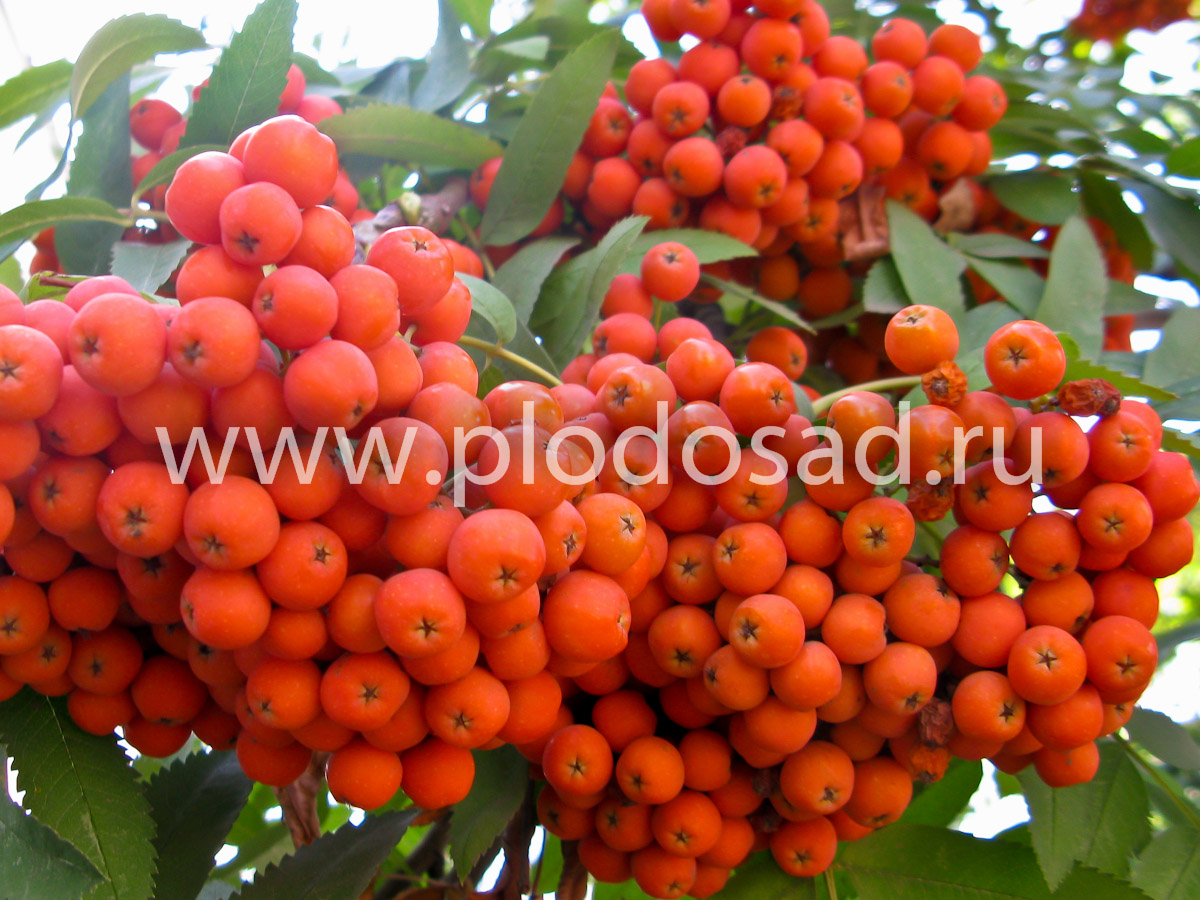
Kuban black
Black apricot is superior to apricot ordinary and in resistance to diseases (moniliosis, klyasterosporiozu, cytosporosis), and winter hardiness, especially in resistance to cold snap in late winter. Therefore, it bears fruit more regularly than ordinary apricot in southern Russia. It is advisable to test its new varieties even in more severe conditions - in the Volga region and the middle lane up to Moscow (and, by the way, it is better in a no-stem and low-stem bush-like form). Plants are placed at a distance of 4 - 5 m. All varieties are well pollinated with each other, as well as plum, Russian and Chinese plum and common apricot.
Black apricot is propagated by grafting on cherry plum, apricot, clonal rootstocks: Kuban-86, Alab-1, Eureka and others, as well as green and lignified cuttings. Black apricot, especially its varieties Alab-1, Alab-2, Afgan, is also used as clonal rootstocks for plum, apricot and peach.
Nectarine - peach hollow
The fruits of peach are usually covered with fuzz, but there is still a rarely encountered variety with an absolutely smooth skin, like plums, and why they are called hollow fruit. This is the fruit of nectarine. Back in the times of the Soviet Union, their collection, collected in the Nikitsky Botanical Garden, was shown to me by an enthusiast of this culture who had done a lot for its rooting in the southern regions of the country - E. N. Schoferistov. The impression was stunning: huge, peach-sized, all the colors of the rainbow are plums, and the taste ... if there could be anything sweeter than a peach, then it is nectarine. And by the way, he got his name from the word "nectar"!
Later I asked E. N. Shofeistova to write an article about nectarine and now I suggest that you read it to you, because you can’t tell about it better than a connoisseur of this culture.
By biological features and the chemical composition of the fruit nectarine is close to the common peach. But on the world market, it is much more in demand, because it is sweeter and its dietary advantages are higher than those of peaches. A significant advantage of the fruits of nectarine over the fruits of peach ordinary is the lack of pubescence of the skin, which simplifies their fresh consumption and processing technology. Nectarine fruits are distinguished from peach pubescent and higher dry matter content. This contributes to their transportability.
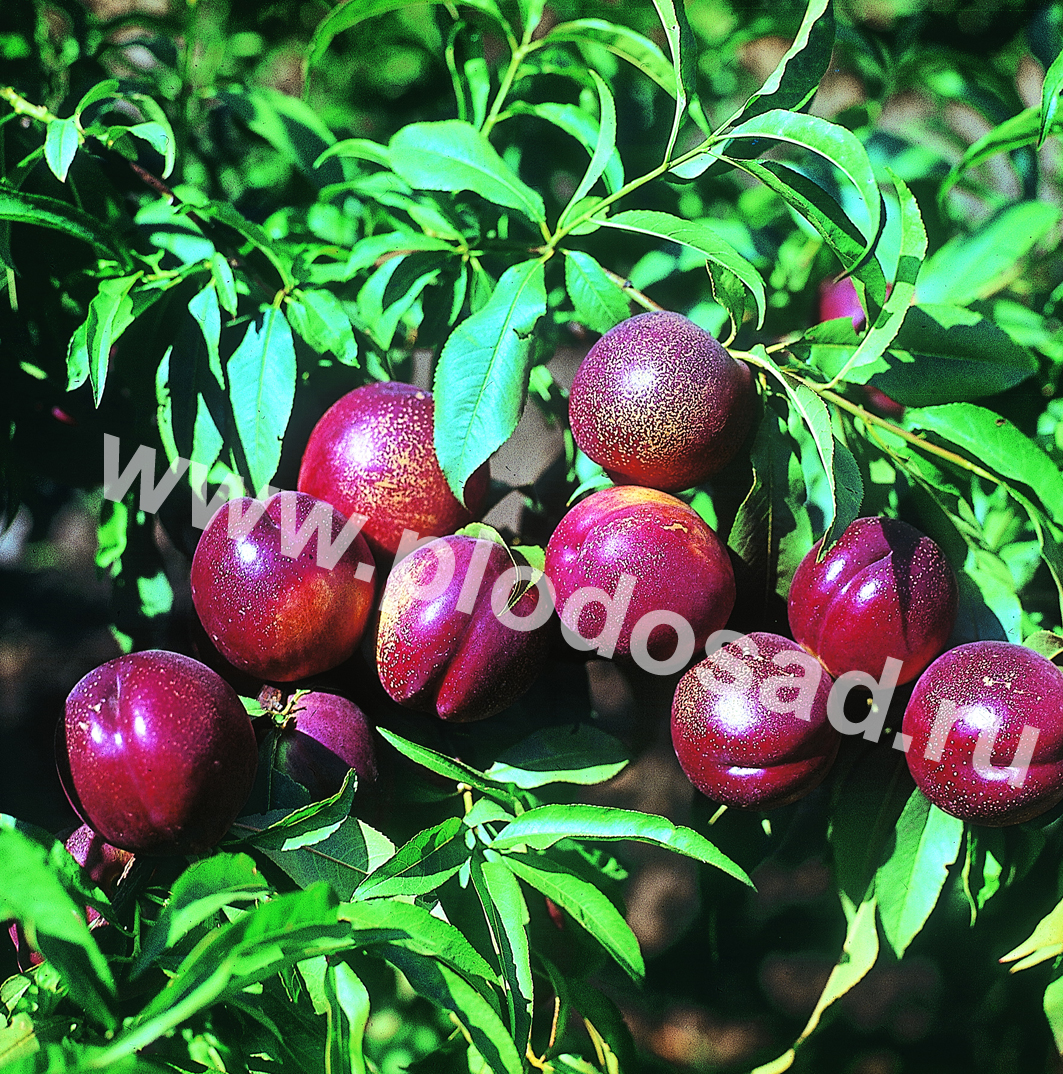
Undoubtable Grade
In the fruits of nectarine, as in the fruit of the peach pubescent, contains a rich complex of biochemical substances, which determines their therapeutic and prophylactic effect. They enhance the secretion of digestive glands, contribute to the digestion of poorly digestible and fatty foods, play an important role in removing fluid and sodium from the body, and therefore are useful for the prevention of atherosclerosis and hypertension.
In some varieties of nectarine, the kernel of the seed is sweet and can be used as the kernel of almond, especially since they are very similar in biochemical composition. Bitter-graded fatty oil is used in pharmacology as a solvent in the manufacture of medicines and ointments. The shell of the nectarine seed goes to the production of activated carbon. Wood is well polished and suitable for various handicrafts.
Nectarine will provide your family with fresh fruits and raw materials for home-made products throughout the summer months. Of particular importance are the early varieties of this crop (Nikitsky-85, Chinese-51312, Crimson Gold, etc.). Their fruits ripen much earlier than all other stone fruit crops.
From nectarines prepare candied fruits, jam, jams, dried fruits. They are frozen whole, harvested in the form of pasta and slices in sugar syrup.
The technology of cultivation of nectarine is the same as peach ordinary, but many of its varieties are more susceptible to fungal diseases (powdery mildew, fruit rot). This should be taken into account when planting nectarine and provide for additional measures to protect plants from disease. For example, nectarine is best placed away from the plantings of the usual peach.
Nectarine is used in the decoration. In the spring, during the violent flowering of its trees with beautiful, large and bright flowers on short pedicels are unique. They produce a delicate subtle aroma of essential oils and are actively visited by bees and other insects. And it is not surprising - after all, nectarine is a wonderful honey plant. In the summer, at the time of ripening of the crop, the nectarine trees delight with charming, bright fruits, filled with sunny juice.

Dessert taste, unique aroma, pleasant, tender, melting, juicy fruit pulp, ease of canning (the skin of the fruit is not removed) - all this contributes to their popularity and rapid spread in industrial and amateur gardening.
In Russia, the hollowed peach came in 1866 through the Nikitsky Botanical Garden. From here it spread throughout the Crimea, penetrated into Western Ukraine, Moldova, the south of modern Russia. In the Nikitsky garden a thorough scientific work is carried out with him, new varieties are bred: Evpatoriysky, Ishunsky, Krymchanin, Poseidon, Ruby-8, Souvenir, Nikitsky and two especially promising varieties - early-ripe Nikitsky-85 and early-medium term of maturation Ruby-4.
Nectarine has received particular popularity in the last two decades of the twentieth century, when its large-fruited (150-200 g) yellow-eared varieties appeared, attracting attention with their appearance and universal use. Gardeners, often with bewilderment and caution, acquire nectarine as a “large-fruited plum”. And indeed, in a very remote time, one type of plum, the Chinese plum, participated in the formation of nectarine. It was from her that the nectarine inherited hollowness, a peculiar pleasant taste and aroma. But scientists also found that along with the plum, certain types of peach, almond, apricot took part in the formation of nectarine.
In our country, only one kind of nectarine is zoned - Krasnodar (1988, North Caucasus region). It was created at the Crimean Experimental Selection Station of the North Caucasus Zonal Institute for Horticulture and Viticulture.
The fact that in our country the varieties of nectarine, even in the southern regions do not yet exist, indicates a lack of attention to this culture. Look in the shops and in the markets - what a variety of nectarines brought from abroad!
The second coming of the large-fruited cranberries
For the majority of Russians, cranberries are a short shrub with small and sour berries, abundantly growing on the peat bogs of sphagnum bogs, which is why this species is called marsh. For the peculiar taste of the berries and their healing properties in the northern regions, it is quietly introduced into the gardens and even the first varieties have been obtained. And now an unknown American species is rapidly penetrating to us - cranberries are large-fruited. Its cultivation began in North America in 1816, and now here it grows on more than 12,000 hectares. Berry picking exceeds 200 thousand tons. Since the nineteenth century, large-fruited cranberries began to be bred in many European countries. At the end of the XIX century, it successfully grew even in the St. Petersburg Botanical Garden. Unfortunately, after the revolution, there were no traces of large-fruited cranberries in Russia; so that its appearance in our places (delivery comes mainly from Belarus) is like its “second coming”, and it looks like a triumphal one.

Large cranberries
What are the advantages of large-fruited cranberries compared to our marsh? Firstly, it has unusually large berries - up to 2.5 cm in diameter. The variety of their shapes is also impressive: they can be round, oval, oblong, pear-shaped. Color from light red to dark purple, usually with a waxy coating. Those who first saw the berries of the large-fruited cranberries are most likely to accept them for the fruits of the whales used on the “paradise apples” jam so beloved by us. They taste sourish, not without originality of cranberry flavor and incomparably with any other fruits crunch under the teeth. It is important that in comparison with the marsh, the fruits of large-fruited cranberries are noticeably richer in many substances vital for humans. Much ahead of the large-fruited cranberry marsh sister and the crops. But still, dear gardeners, large-fruited cranberries, although, of course, they will take their rightful place in Russian gardens, however, being carried away by this American woman, do not forget about our native, marsh, cranberries.

Cranberry marsh and large-fruited
The marsh cranberry growing in Russia is very winter-hardy and undemanding to the conditions of life. Well, and what the fruits are too small - so make a selection. It is also promising to cross the best varieties of American cranberries with the best domestic ones. And by the way, our scientists also did not sit idly. On the Kostroma forest OS, its first varieties have already been created and, moreover, they have been studied in comparison with the 16 most common American varieties. The "competition" of two types of cranberries on Russian soil revealed a clear advantage of the domestic one. Cranberry varieties are more frost-resistant than large-fruited ones, they produce fruits more stable. Often they are not inferior to the "Americans" and the size of the fruit, which is also better stored.
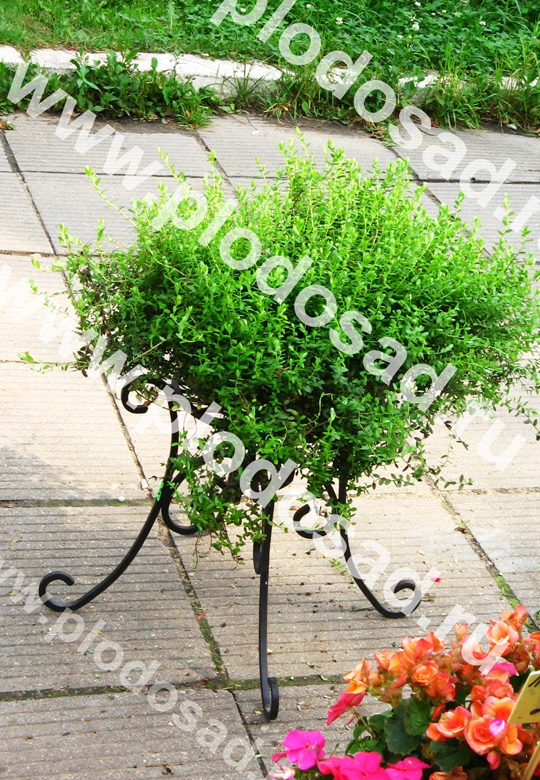
Large-sized cranberries in a decorative design
Large-fruited cranberries are also interesting decoratively. First, it (as well as the marsh) is an evergreen. In spring and early summer, when young shoots grow, the plantings turn out to be light green; during flowering (from mid-June to mid-July), they take on the appearance of a soft pink carpet. But a truly unforgettable sight is the large-fruited cranberries in September, when its fruits and leaves turn orange-burgundy.
Cranberry large-fruited under the snow cover is able to withstand temperatures down to minus 20º - 30º. But still in the late autumn it is better to cover it with something (suddenly there will be little snow), for example, with leaves, fir branches, spunbond. Early harvest and late autumn frosts are dangerous for harvest.
Cranberries belong to the lingonberry family, and for all the berry shrubs (lingonberries, blueberries, blueberries) that are part of it, sour soils are required when cultivating in the garden - the optimum pH for cranberries is 3.5-4.5. A decrease in pH has little effect on their growth and development, but an increase causes cessation of growth and death of plants. This is due to the fact that cowberry lacks root hairs that absorb nutrients from the soil, and their function is performed by mycorrhiza (a symbiosis of the root and fungus), and it only works in an acidic environment. By the way, this is why wild cranberries grow only in acidified sphagnum bogs. Therefore, the best soil for cranberries (and other lingonberry) - sphagnum sour peat, which also has three other important properties - good aeration, high moisture capacity and the lack of weed seeds (weeds do not grow on bogs). It can be used both in pure form and with the addition of sand (3: 1), 15-20% of the volume of garden land and up to 30% of leaf, and even better coniferous litter.
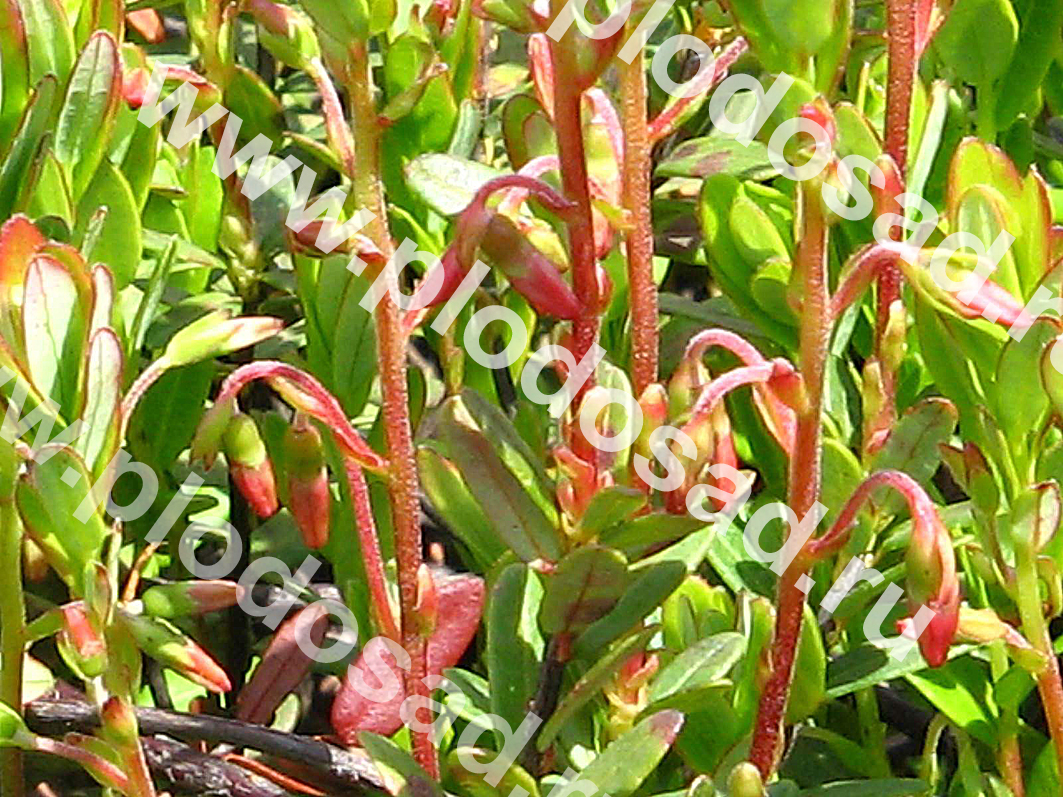
Before flowering
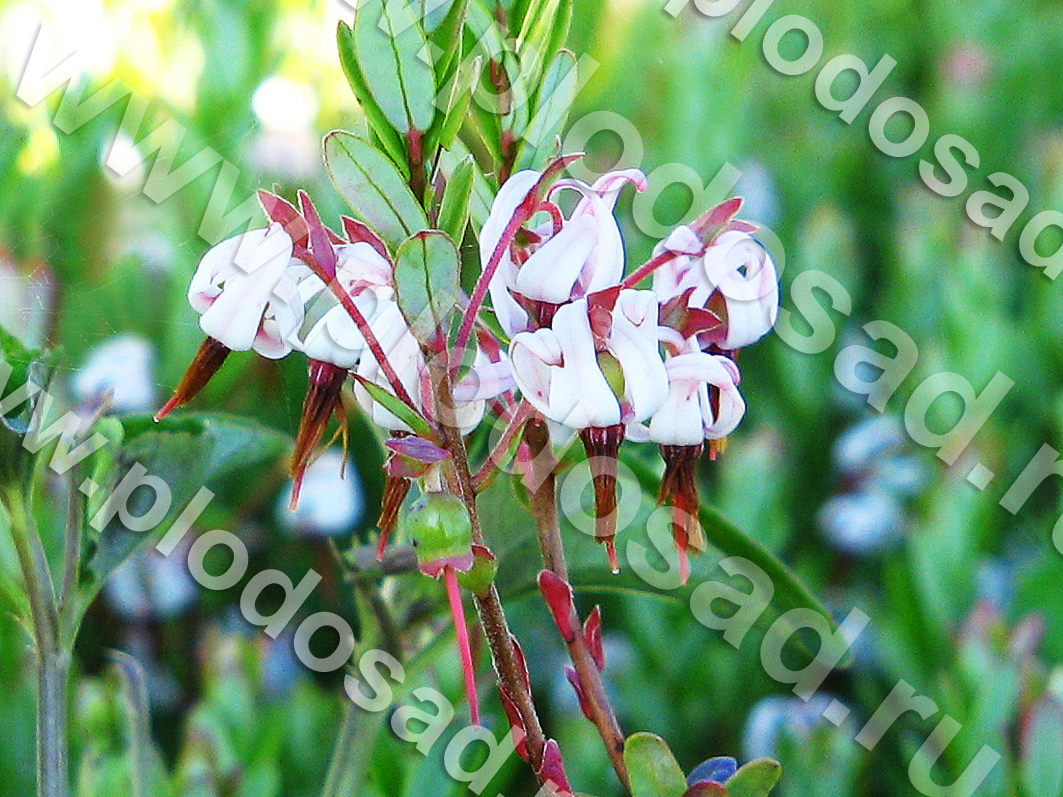
Blooming cranberries
It would seem strange, but cranberry is not a particularly moisture-loving plant, and therefore it cannot be used in lowlands where water stagnates, and during irrigation it is enough just to make sure that the top layer of soil does not dry out. Groundwater deposition should not exceed 30-40 cm.

Large cranberries
Cranberries can be bred on any soil, even on heavy and clayey, but for this you need to build beds. Their size and configuration can be very different, up to a square, a circle, an oval, etc. For this, after deep digging and removal of rhizomes, the top layer of soil (20-25 cm) is removed, and the resulting groove is filled with peat (or a mixture made on its basis ), which is thoroughly compacted and watered. When other components are added to peat, its acidity decreases and therefore when using the mixture, it is advisable to pour the prepared bed with acidified water (10 liters of water per 1 m²). Citric acid and oxalic acid are used for acidification - 1 tsp for 3 liters of water, acetic acid or malic acid (9%) - 100 g per 10 l of water, and even better an electrolyte for acid batteries (diluted sulfuric acid) in an amount of 50-100 ml 10 liters of water. If there is no top peat, then take any other peat, but then for acidification, sprinkle it with sulfur (40-60 g per 1 m²) and mix thoroughly. In the future, any peat and substrate are regularly acidified every two to three years.
If the site is located on peatlands, then the cranberries can be planted without special training, it is only important to isolate it from the rhizomes of weeds.

Cranberries in the fall
Cranberries are planted in a wet substrate with seedlings with a clod of earth, in holes 10 cm deep and 8-10 cm wide. The distance between plants is 20-30 cm. The plants are watered and mulched with sand. During the week, make sure that the top layer does not dry out, then water once or twice a week (1 bucket per 1 m²), in dry weather - every day.

Cranberries in winter
In the spring, once every 2-3 years, it is advisable to land the surface of the plantings with a 2-3 cm layer of sand. Due to the light reflected from the sand, the illumination of the lower leaves, which is so important for the cranberry, increases, and the soil warms up even better and faster, and its water-air quality improves. mode, delayed growth of weeds.
Cranberries are not demanding of soil fertility (after all, it grows in barren swamps), but it responds well to low doses of mineral fertilizers, especially when fractional - 2-3 times during the growing season. Nitrogen-containing fertilizers are especially effective for it, but in order not to cause prolonged growth, they are used only until August. When choosing potassium fertilizers, chlorine-containing ones are avoided: potassium chloride, potassium salt, giving preference to potassium sulfate. There is a positive experience of using Kemira Universal for its fertilizer in the spring or early summer, and Kemira-Autumn in the fall. But manure and cranberry compost are doom, so be careful.
Harvesting cranberries. Belorussia
Photos by TV Kurlovich 

Selection of varieties of large-fruited cranberries are primarily taking into account the security of ripening in the area with summer heat.
In areas where the sum of positive temperatures during the growing season exceeds 2,700 degrees, all varieties can be grown, and where their sum is less than 2,300 degrees, only middle-ripe varieties will fit early and with some risk. The early maturing (ripening at the beginning of September) includes varieties - Early Black, Ben Lear (Ben Lear), Black Veil (Black Veil), middle ripening (ripening in mid-September) - Searl, Wilcox (Wilcox), Franklin.

Irina Sergeevna Isaeva,
Photos from the archive of I.S. Isaeva
Feijoa's subtropical exoticism - to the tub culture
Feijoa is a relatively new, evergreen subtropical plant. Her homeland is South America, where the local population has long since gathered its fruits in the forests. At the end of the 19th century, feijoa was brought to France, Italy, Algeria, from the beginning of the 20th century to Spain, Portugal, USA, India, Japan, Australia. It came to Russia (Yalta) in 1900, and since 1903 it began to spread along the Black Sea coast of the Caucasus (Sukhumi, Sochi, Batumi). At first it was grown as a rare fruit and ornamental plant in gardens and parks. Now feijoa is grown in family gardens.
Feijoa fruits cannot be confused with any other fruit: they are distinguished by a strong strawberry and pineapple, reminiscent of both, aroma and characteristic taste, with a harmonious combination of acid and sugar. The value of the fruits and in their healing propertieswhich are determined by the richness of the biochemical composition. They are high in content. R- active substances, ascorbic acid (vitamin C), rich in pectin. The uniqueness of feijoa fruits is the presence of iodine in them, which means that they are an effective remedy for the treatment and prevention of thyroid hormone deficiency, cardiovascular and other diseases.
Once you see a feijoa during flowering, you will not confuse it with any other plant either. You look at its flowers — large (3–4 cm in diameter), purple-red, with white petals and numerous stamens red with yellow anthers, and it seems that this is something fabulous, some very “scarlet flower”. And this beauty of flowering lasts for a whole month.
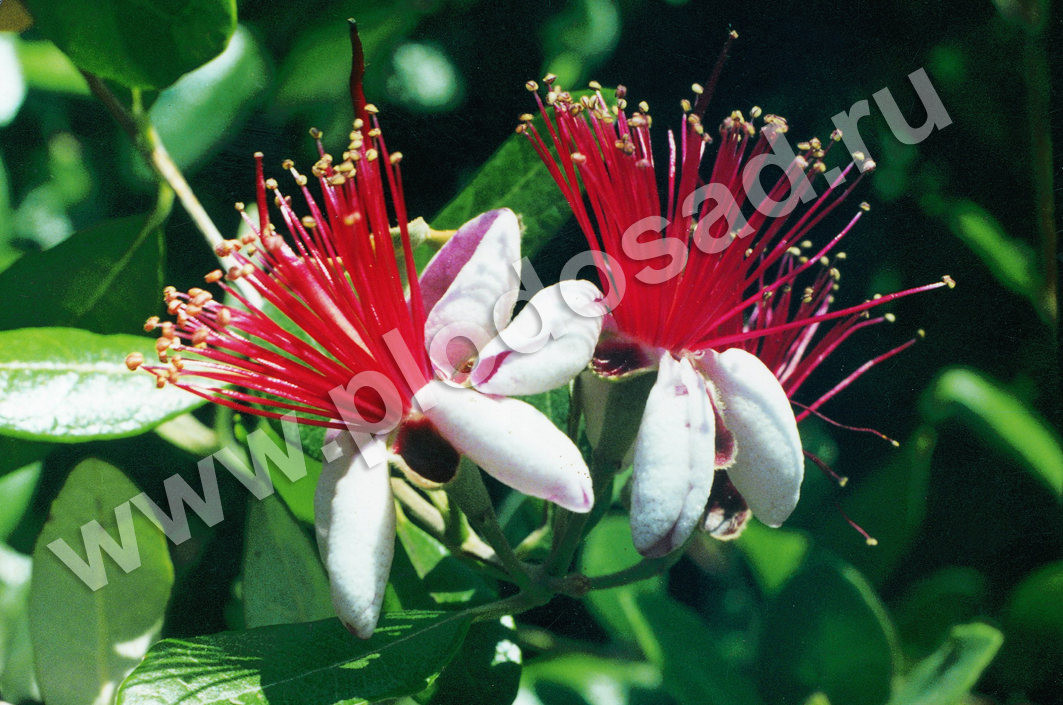
Feijoa during flowering
Like any subtropical plant, feijoa is thermophilic. For normal development and fruiting during the growing season, it requires a total of at least 3,500 - 4,200 positive active temperatures. The optimum temperature of the air during the growing season is plus 18 - 22 degrees, for flowering - 20 - 25. Without damage, lowered temperatures tolerate to minus 10 - 12 degrees. At minus 15 - 16 degrees, leaves and annual shoots are damaged. And at lower temperatures, the whole plant dies.
But the gardener is so arranged that what he doesn’t have, that’s what he wants more. Surely many gardeners from the central regions of Russia wanted to dissolve their feijoa. Well, I want to - breed, that's just with a serious limitation - not in the garden, but in a tub culture. Feijoa is a shrub up to 2.5 - 3 m in height with a crown diameter of up to 3 meters. If its growth is still a little restrained by pruning, then the plant may be even smaller volumes. With the necessary care, the conditions of closed ground transfer safely. So put a tub (and even better 2 - 3) with this exotic plant in your home and enjoy its aroma, beauty of flowering and unusual to taste, medicinal fruits.
Growing feijoa in the tub (pot) culture
Feijoa reproduction
Feijoa is propagated by seeds and vegetatively. Of course, it is better to plant a vegetatively propagated plant in the tank, which is done by cuttings or rooting lignified and semi-woody cuttings. In this case, the plant properties of the variety are preserved to the fullest extent and one or two years earlier (compared to seedlings) fruiting begins (during seed multiplication, fruiting begins in the fourth or fifth year, and in the vegetative period - in the third or fourth). But it is difficult to get vegetatively propagated plants of the feijoa to the inhabitants of the middle lane, so most likely you will have to resort to planting a seedling.
Feijoa fruits ripen in October-November, at the same time they fall into our markets. Buy the most ripe fruits, cut them and remove the inner most seed-filled part. By the way, feijoa seeds are more than enough - 60 or more per fruit. They are very small, and therefore in one gram they contain up to 400 - 800 pieces. It is important that seed germination is very high. Just do not keep the fruit for a long time, as the seeds begin to germinate in them.
The seeds removed from the fruit are placed in a softening tank, after which they are washed, separated from the pulp, dried in the shade and stored until sowing in a dry place. Feijoa seeds are sown in very early periods (January – February) in boxes for glass or film. The boxes are filled with soil composed of one part of humus, two parts of river sand and one part of sod land. The land should be loose, well sifted. The seeding depth is shallow, no more than 0, 5 cm. When the moisture is normal and at a temperature of + 20-25º C, shoots appear in 12-15 days.

When seedlings develop one - two pairs of leaves, they swoop into separate containers. The composition of the soil: sod land (3 parts), leaf humus (2 parts), rotted manure (0.5 parts) and river sand (0.5 parts).
In order to achieve the fastest possible entry of plants into fruit bearing under room conditions, they must be grown in the form of a tree on a low trunk. For this, when the seedlings reach a height of 25 to 30 cm, they are cut to one third of the height. On the side branches form shoots of other orders. Shorten and pinch only vigorous shoots. The cut is made above the kidney. Forming is carried out before the start of growth. In the future, weak or dried branches are removed, and thinning is carried out if necessary.
Plant care
Feijoa - light-loving culture, so the plants are better placed on the south or south-east windows. Most of the plant suffers from a lack of light in the autumn-winter period. As an additional light you can use a fluorescent lamp.
The culture does not tolerate intense heat. Feijoa is a inhabitant of a subtropical region with a very mild oceanic climate. Peresushka earthy coma leads to the discharge of leaves, the death of the branches. It is useful to spray the plants with water, this will increase the humidity of the air. Especially, feijoa needs moisture in the first half of the growing season, during the period of intensive growth.
Watering should not be allowed cold waterthat stops the growth of the root system, leads to acidification of the soil in the pots.

Feijoa culture
The plant is relatively undemanding to the soil. But, being in a small amount of soil, it constantly needs additional nutrition. It is necessary to carry out feeding. The smaller the vessel, the more often need feeding and watering. It is recommended to make 30 g of ammonium nitrate and 30 g of potassium salt per 10 liters of water. Superphosphate (50 g per 10 l of water) is first boiled for 45 minutes, settled and the precipitate is drained. Can be applied simultaneously with mullein (1:10). The day before fertilization, the plant must be watered.
Most varieties and forms of feijoa are self-sterile (bear only when cross-pollinated), but self-fertility forms are also found. For growing in room conditions need just such forms or plant at least two plants.
A characteristic feature of feijoa plants is their high phytoncidity and hence a rather high resistance against pests and diseases. But sometimes lovers are faced with the spread of scarab on the leaves. Shchitovka settles on a glossy surface along the main vein.
For protection, you can use a tool made from the leaves of a green walnut pericarp. 100 g of green or dry leaves, pericarp insist during the day in one liter of water. Spray the filtered solution.
Aktara is a broad spectrum insecticide, low toxic for warm-blooded animals. It has a contact and intestinal effect on pests, which manifests itself 15 to 30 minutes after contact with the drug. Effective against sucking (aphids, shchitovki, whitefly, thrips).
In winter, it is desirable to cultivate in cool, bright rooms (10 - 12º C). From spring to the onset of frosts, plants can be brought to the balcony.
Delicious healthy fruits, beautiful emerald greens, original flowers, a relatively simple agrotechnical cultivation, a high level of adaptation - all this suggests that there is something to work for and introduce this exotic feijoa to your favorite indoor plants.
I.S. Isaeva,
E.L. Shishkin,
researcher Nikitsky
Botanical Garden, Yalta
(e-mail: [email protected]).
Shiksha
What just do not try to cultivate restless gardeners in family gardens. We even got to shiksha. In nature, it is common in the tundra and taiga zone of Eurasia, and grows in the tundra, and in swamps, and in marshy forests. Gardener shiksha attracted unusually high vitality, even in the extremely harsh conditions of the North, in combination with completely edible and healing berries. Berries of shiksha are blue-black, like a crow's wing, for which the plant has also received the name "crow". And for wateriness, it is also called vodyanika.
Shiksha is an evergreen shrub, with long (up to 1 m) creeping along the surface of the soil and partially moss-covered shoots, with small, like needles, leaves. The shrub height is 20-40 cm. The flowers are solitary, small, bisexual or dioecious, from pink to red, pollinated by insects.

The value of shiksha berries is primarily in the high content of vitamin C, which they have several times more than in lemon. In addition, they are a reliable diuretic that northerners have been using for centuries. More recently, an effective antiepileptic drug from shiksha, Empretrin, the first herbal medicine in the world from this severe disease, has been transferred to clinical trials. For the treatment, in addition to the berries, above-ground shoots are also used, which are collected during flowering. In the people it is believed that infusions of them cure at least a dozen diseases.
The watery and overly bland taste of siksha berries does not prevent the local population from collecting them in large quantities. Of course, this is primarily due to the fact that no other berry plants often grow in the places where shiksha grows, and also with the relative ease of their collection. The ease of picking shiksha berries is due to the fact that it grows in thickets, is very fruitful, and besides, its collection is quite long: the berries ripen in early August and remain on the plants until spring.
Berries are eaten with milk, sour milk. In the winter they are soaked, frozen, used for jam, drinks (only then you need a lot of sugar). Connoisseurs recommend that the cake remaining from processing berries should be chewed as a kind of chewing gum - a useful load for gums and teeth. If to swallow cake, then it, as if a sponge, clears intestines. It is important that the berries do not lose their properties when they freeze, moreover, unlike other berries, they do not even freeze into a lump. The local population has recently stored them in large numbers in pits lined with ferns in bulk. In the winter food of the northern peoples, the popular dish, which the Russians call Tolkusha, is popular. It is a mixture of shiksha berries with finely chopped fish and seal fat.
Hunting to siksha berries and animals with birds. And the bear, before lying in the den, rows it in its mouth with its paws, a handful of berries - a sip of healing juice. Take a closer look at this harsh northerner, it seems it is time to draw her into our family gardens.
I.S. Isaeva
doctor of agricultural science
Ginseng near Moscow
Beloved Tatiana Valentinovna devoting
I met the author of this article, a remarkable gardener-experimenter from the Moscow region, Vladimir Vasilievich Nikolayev several years ago, when I came to his dacha to see the fruiting thicket of his famous cornel. And it turned out that a small, but very productive ginseng plantation is no less remarkable for his garden. I saw the planting of this very rare plant in its homeland - the Far East, but at the summer cottage in the Moscow region I met its plantation for the first time. And what was seen was amazing. And then Vladimir Vasilyevich, having come to visit me, brought as a gift a few ginseng roots, indeed, as I read about it many times, resembling little men. And he said: "Cut it in small pieces and just chew."
Of course, ginseng is not a fruit plant. But since it grows in a garden, then, albeit with a stretch, we will place it among rare fruit plants. I really wanted Vladimir Vasilievich to share his experience in growing ginseng, which any gardener can undoubtedly adopt. I wish you success in this very interesting business.
I.S. Isaeva
doctor of agricultural sciences
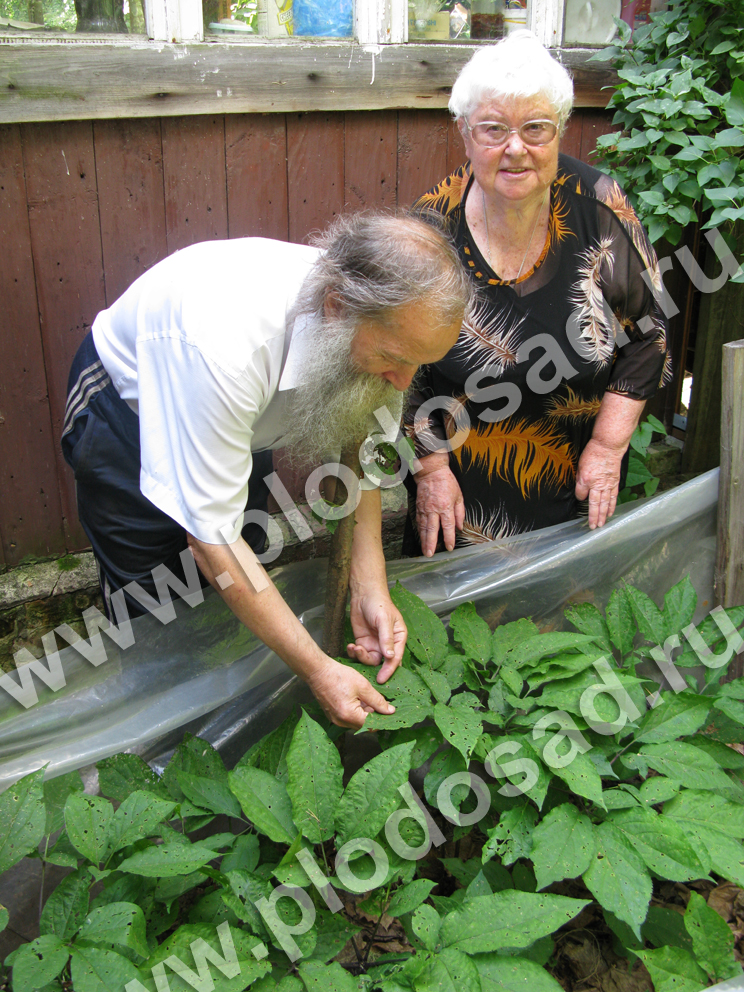
In my early years, solving complex mathematical problems in school and institute, I thought about those medical substances that enhance mental processes. From dad and grandfather I learned about ginseng. Being a student and earning a little (part-time working as an engineer), once at the Central Pharmacy No. 1 I bought a bottle of ginseng water extract prepared in China. Began to use it in droplets. I read about the methods of its cultivation, methods of preparation, and all this was then available. This is the 50s.
In our neighborhood next door lived a famous gardener, an experimenter Alexandra Semenovna Frolova. She shared with her neighbors different new garden cultures. We made an exchange with her. I gave her dogwood seedlings, and she gave me a few ginseng roots. Naturally, having been delighted, I prepared the bed in the best place, in the center of the vegetable garden, and planted ginseng roots there. I remember that in spring they came up, and by June or earlier everything had lowered the leaves, withered and, naturally, died.
In the following years, reading magazines and books, studying how they grow ginseng in Korea and China, I decided to try again. Knowing that the ginseng leaf after 15 minutes of illumination in direct sunlight fades, I found a place in the area where direct sunlight does not fall during the whole day. I dug a hole about 2 shovels in the depth of 50 cm near the terrace at the distance of 1 m from the wall. The fact is that the water flowing from the roof should not fall on the leaves of the plants. Rain should not water the plantation.
We have sandy soil. To the dug out sand, the birch tree stumps were added, taken in the forest, peat and ashes. He poured this hole over this mixture. Along the beds, on the west side, buried a pine log with a diameter of 20 cm. It was in 1986
In the autumn of the same year he wrote to Primorye Territory, Sergienko Nikolai Fedorovich with a request for the expulsion of 20 roots and 30 seeds. Earlier in the magazine "Beekeeping", and others, printed ads with proposals for the transfer, sale, exchange of seeds and seedlings. Now these ads have become less or none at all.
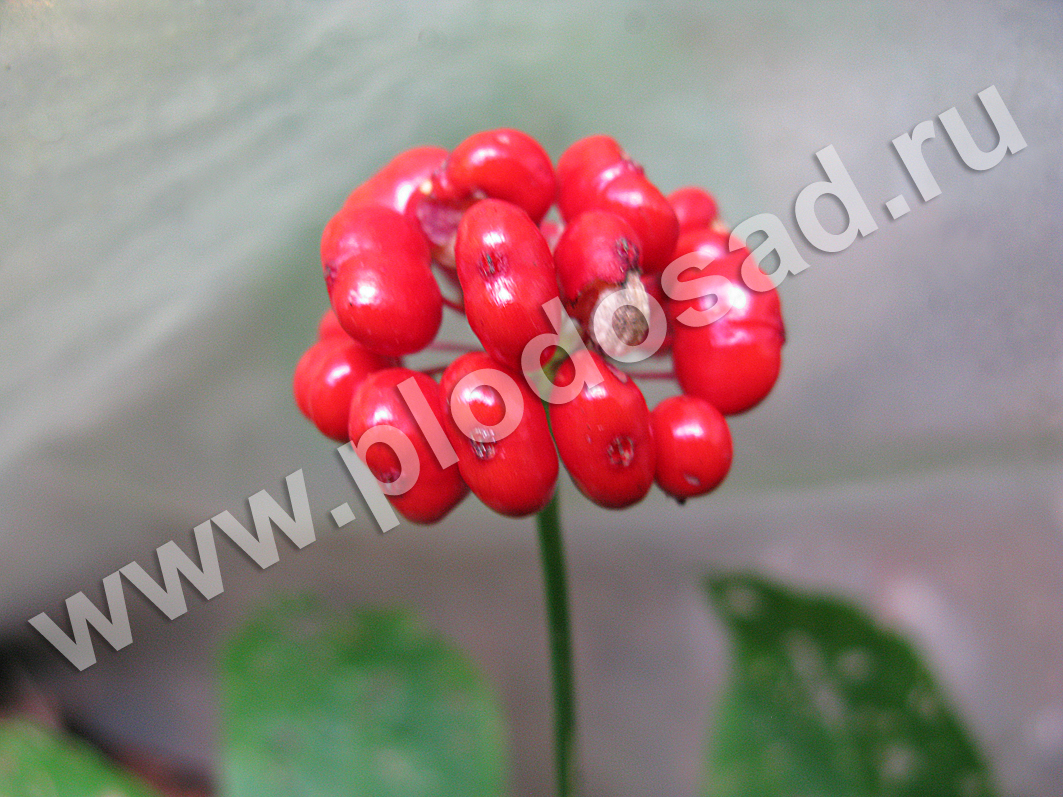
Fruiting ginseng
Received in September, an award of 40 p. in honor of the fiftieth anniversary, I, with the consent of my wife, “thumped” this money in Primorye for the roots and seeds of ginseng. But they gave me roots and seeds only next year, in the fall. The roots were the first year, small. This package arrived in Zelenograd. When she received it, it was already opened. Apparently, everything that was sent to our Zelenograd was subject to verification. But I got all 20 roots and 30 seeds. Many thanks to Nikolai Fedorovich. The correspondence with him continued. All planting and transplants I do with the phase of the moon. I sow the seeds on the third day after the full moon in September.
Most of the roots and seeds were planted and planted near the terrace. 3 roots planted elsewhere, in the corner of the garden. There was no sun at all. After a few years, I returned them from there to the common garden bed. The size of the beds is 1 mx 1.5 m. It is enclosed with a film so that neither cats, nor hedgehogs, nor other animals or birds will enter it. After all, if a cat passes just once in 25 or more years, it can do such a thing, that all the many years of work will go down the drain.
Water to the plantation should not come from above: neither rain nor dew should fall on the leaves. Naturally, water, always colder than the surrounding air, falling on the sheet, creates an unpleasant effect on the plant. Therefore, on rainy and cloudy days, the bed I cover with a transparent film. And the water supply to the roots of plants is due to capillary processes on the side of the bed. And on all sides laid a rotting sheet, which the ridge was covered in winter. The leaf is always moist, decomposing, saturates the soil around the ridge with nutrients, which together with water come from the side and bottom to the roots of plants.

Vladimir Vasilievich came
to visit me, holding in my hands so resembling a little man ginseng root
Three years have passed since the day of landing. On the fourth spring, several plants bloomed and in August gave the first berries. From these berries I took the first seeds of my own and sowed them on the same bed. A few seeds planted in the forest. Currently, all the old roots emit a peduncle. But I cut them off, leaving only one root, and each year with different ones. This technique increases the weight gain of the root and creates favorable conditions for an even greater increase in the mass of the root, since they increase the number of shoots. There is such a tendency: first, two shoots grow at the root (I think two heads). In about three years, there are already three heads, in the next three years, four heads. Some heads fall asleep for a year, others grow annually. One root has five heads. The increase in the number of shoots (heads), in my opinion, speaks about the correctness of cultivation: the right place, optimal lighting and the supply of water and nutrients.
There are about 38 roots of different years growing on a bed - from two-year-olds to twenty-five years old (some are sleeping). I dig one root a year, and sow 5 seeds. Use as a carrot. I cut a piece in the autumn and winter after a hearty lunch on cold days. Keep in the fridge.
I do not make any tinctures, extracts and jams in sugar or honey.
140g root is enough for me for a year.
Go ahead and grow ginseng. The main thing: the light reflected from the sky sunlight (do not allow direct sunlight on the leaves). The plantation should not be wet from above, but only lateral watering (watering with rain or only between the watering cans).
Neither the dew nor the rain should fall on the leaves and soil around the plant.
Protection against the penetration of animals on the plantation during the entire period of cultivation (which is decades). Moles are the helpers of ginseng growers. They dig deep channels and do not damage the roots at all.
Removal of peduncles in May, as soon as they appear from the rosette of leaves.
You can feed in the form of old mushrooms (white, boletus, oil, etc.), putting them between plants on the ground.
Vladimir Vasilievich Nikolaev
(tel. 8-916-845-87-01, e-mail [email protected])
Photos I.S. Isaeva
Rowan - fruit tree
Flush northern garden called rowan. And how good it is, especially in the late autumn at dusk of the day or in wilderness, when the snow accumulated on the clusters as if covers each of them with a lace cap, an intricate panama or a simple scarf. And then the waxwings will fly in, ring the bells, and later, on a frosty day, the tree will be decorated with red apples - bullfinches have already arrived. Birds do not live in a snowy season without a rowan tree, and man has long been friends with it.
Of 84 species of mountain ash in the middle lane and much more to the north, only one species grows - mountain ash, which withstands winters even with temperatures as low as minus 50 degrees. In addition to adherence to it as an unusually elegant tree, in Russia this rowan has always been valued for its ability to be used for various economic purposes and, of course, above all for the nutritional and therapeutic value of fruits.
The fruits of mountain ash in terms of the content of biologically active substances necessary for a human being are equal to wild rose and sea buckthorn. It is important that they are especially rich in carotene, which accumulates there twice as much as the main source of this substance for residents of the northern regions - carrots. According to the content of vitamin C, it competes with lemon and black currant, vitamin P in it accumulates up to 700 mg or more per 100 g of fruit. To satisfy the need for these three vitamins, it is enough to eat just one brush of berries per day. And mountain ash contains up to 2 mg per 100 g of fruit of vitamin E that promotes normal sexual activity, about 1 mg per 100 g of fruit of vitamin K 1 that normalizes blood coagulability. The fruits are also unique in the content of sorbic and para-sorbic acids, which inhibit the growth of microorganisms, fungi, and mildew, why they prevent gastrointestinal infections when used for food. And this is not a complete list of the healing possibilities of mountain ash.

The twentieth century was marked by widespread introduction to the culture of many wild fruit and berry plants. Their active introduction into culture was dictated by a catastrophic decrease in the number of wild plants in nature, difficulty in harvesting, low productivity, and besides, they wanted to “correct” the quality of the fruits. Among the newfound crops in the garden was a rowan. Its first varieties, as was the case in other cases, were also created by I. V. Michurin. This - Liqueur, Burka, Garnet, Michurin dessert. The followers of I. V. Michurin donated varieties to our garden: Alai large, Angri, Businka, Vefed, Daughter Kubovy (Solar), Titan, Sugar Petrova. In addition, the sweet fruit form of the mountain ash, Nevezhinskaya (the name is given by location) and another sweet fruit form, from the Sudeten mountains (Moravia) - Moravian (its taste is less interesting than Nevezhinskaya).
It is still rare to see varietal rowan in gardens. And it's a pity, because it is not only quite edible and fruitful, but its fruits are also much more dietary and wild-growing. The fact is that parasorbic acid creates excessive bitterness of mountain ash, which is apparently toxic and causes a feverish state. In the fruits of the same transformed, varietal rowan of this acid is less, which means that they are safer. At the same time, the composition and amount of biologically active substances in the fruits of varietal rowan vary in grades, but still turn out to be quite high, close to the composition of wild rowan fruits.
The most delicious fruits of the varieties Sugar Petrova, Angri, Businka, Vefed, Ruby. If the Ruby's fruit in a gauze bag is put under a hot battery, then, when they get wedged in, they become like raisins. Varieties differ in yield. The most fruitful are Burka, Businka, Scarlet Dessert, which, at the age of 20, yields up to 150 kg from a tree, and each shield with fruits often weighs 400 g or more. Not at the same time the varieties come into fruiting - for the 3-4th year after planting the grafted seedling in the garden, Garnet, Burka begin to bear fruit, on the 6th - Bead, Titan, Alai are large, and the rest - on the 7-8th year. It is important that trees of varieties are usually lower. wild species mountain ash, for example, at Angri, Titan and Sorbinka - 3-3.5 and, for Beth and Businka - 2.5 - 3 m, and for the Rubin variety, generally dwarf type - 2.1-2.3 m.
The fruits of most varieties of mountain ash are simply “pure”, as we consume other gifts of the garden, while not particularly singing, they are more suitable for various preparations, which are distinguished by originality and piquancy of taste. The varieties Titan, Alaia major and Burka are recommended for preparing juices; Bead and sorbinka - mashed potatoes; Titan is also used for cooking seasonings, Angri is suitable for jam, marmalades, the fruits of this variety are good and rubbed with sugar. And, of course, you can make original jam from each variety.
If you decide to start a varietal mountain ash in the garden, then remember that, although it has just come from natural conditions, it is already a cultivated, and therefore a plant requiring care.
Planting, care and breeding varietal rowan in many ways resembles an apple tree. Planted as an apple tree, both in the fall and in the spring of 2-year-old grafted seedlings. So that the tree does not lean, it grows straight, like an apple tree, the sapling is tied by a "figure of eight" to a stake in a pit. The size of the pit is 80-100 x 50-60 cm. If the land is not suitable for planting, it is replaced by adding 2-3 buckets of humus to the new soil, 500-600 g of superphosphate, 100-150 g of potassium salt, up to 1 kg of lime or 1 kg of ash. Be sure to water and mulch.

And you can dig up young trees in the forest, just carefully plant them and block them with varietal cuttings. If you want to have one variety - plant it on the stem, if you want to get a multi-grade tree - re-produce each branch with your variety. Vaccination time - spring, way - improved copulation (with tongue).
Like all fruit plants, mountain ash responds well to organic and mineral fertilizers. Nitrogen fertilizers are applied in the first half of the summer at the rate of 10-30 g per 1 m² (calculate how much you need for the tree trunk). In the same amount, phosphate and potash fertilizers are applied in the fall.
A slender rowan tree doesn’t need pruning, but for vigorous varieties, it is desirable to restrain growth using the basic principle of reducing the crown - transfer to the side branch. And you can even grow it in bushy form. To do this, even one year old cut above the third (counting from the root of the neck) a well-developed kidney and then form it in the form of a trifoliate bush.
Rowan, although it can grow in the undergrowth, is a light-loving plant, so choose a lighted place for it in the garden, otherwise the tree will be ugly and low-yielding. The plant is moisture-loving, so in the dry summer, do not forget to water it, otherwise the fruits will be small and tasteless.
Transformed, varietal mountain ash with high taste and dietary qualities of fruits, it is time to open the way to our gardens, especially in regions with risky and limited gardening. At the same time, saving the area of \u200b\u200bthe plot, it is possible to plant 1-2 trees on it and at the same time somewhere in the nearby places inconvenient for agriculture (for example, the slopes of a ravine) to create plantings for the collective use of its crop.
For our distant ancestors, the mountain ash was a tree in which lightning was hidden — the powerful weapon of the god of the thunderman Perun. Tall, slender, especially in treeless areas, the mountain ash tree really served as a lightning rod. So, probably, not only for beauty, but, most likely, unconsciously, and for this reason, she has been planted since olden times in every front garden. In addition, she was considered a defender of evil spirits and at the same time a tree of fertility, all kinds of blessings, the prosperity of the host. Rowan was sanctified and it was forbidden to chop. Over time, all this symbolism has lost its value, but mountain ash has remained a favorite tree, and especially in Russia.
Irina Sergeevna Isaeva,
doctor of agricultural sciences
Cherry felting is improving varieties
 Two or three bushes of felt cherry can be found in many family gardens and the middle belt, and to the north, and beyond the Urals it is almost a common culture. Such a wide spreading of this generally new culture for the Russian garden is primarily due to its at least three outstanding properties: extraordinary winter hardiness - withstands temperatures down to -40 degrees; very early ripening - usually in the middle lane 7–10 days earlier than ordinary cherry (that is, when early varieties of strawberries are just beginning to ripen) and the early introduction into fruiting - the first fruits appear on the third, and often even the second year after planting. In addition, felt cherries are not afraid of mice and hares, when seed breeding inherits parental properties, which means that it can be propagated by simple sowing of seeds; it is attractive and sweet-fresh fruit, which is especially popular with children, and even many, lovers of this taste, adults. I remember how someone "weave" could not tear myself away from the bush covered with its fruits, until the owner came up and delicately recalled: "We have children." And cherry felt is very decorative: during flowering, it is one of the types of cherry, which in Japan is among the plants under the collective name "Sakura", designed specifically for admiring.
Two or three bushes of felt cherry can be found in many family gardens and the middle belt, and to the north, and beyond the Urals it is almost a common culture. Such a wide spreading of this generally new culture for the Russian garden is primarily due to its at least three outstanding properties: extraordinary winter hardiness - withstands temperatures down to -40 degrees; very early ripening - usually in the middle lane 7–10 days earlier than ordinary cherry (that is, when early varieties of strawberries are just beginning to ripen) and the early introduction into fruiting - the first fruits appear on the third, and often even the second year after planting. In addition, felt cherries are not afraid of mice and hares, when seed breeding inherits parental properties, which means that it can be propagated by simple sowing of seeds; it is attractive and sweet-fresh fruit, which is especially popular with children, and even many, lovers of this taste, adults. I remember how someone "weave" could not tear myself away from the bush covered with its fruits, until the owner came up and delicately recalled: "We have children." And cherry felt is very decorative: during flowering, it is one of the types of cherry, which in Japan is among the plants under the collective name "Sakura", designed specifically for admiring.
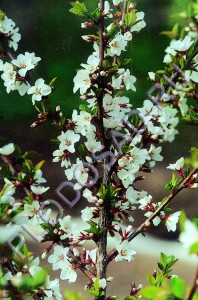 But, unfortunately, like any beauty, felt cherries are not without flaws. This is primarily its early flowering, with the result that it often coincides with frosts, which leads to yield loss. And here the matter is often not even in the probability of frost damage to the flowers, as in the absence of conditions for pollination by bees. A serious disadvantage of felt cherries is the possible root swelling of the neck, which is often the cause of plant death. Especially such damage is typical in areas where thaw occurs in the middle of winter, and plants prematurely leave the state of rest. But experienced gardeners have got the knack of “taking away” cherries from such troubles, and there are plenty of ingenious tricks here: this is planting on elevated, without stagnant spring waters, and reducing waterlogging of roots in the ground by introducing sand and ash into the zone of their location, and grafting on winter hardy, stable in the area
But, unfortunately, like any beauty, felt cherries are not without flaws. This is primarily its early flowering, with the result that it often coincides with frosts, which leads to yield loss. And here the matter is often not even in the probability of frost damage to the flowers, as in the absence of conditions for pollination by bees. A serious disadvantage of felt cherries is the possible root swelling of the neck, which is often the cause of plant death. Especially such damage is typical in areas where thaw occurs in the middle of winter, and plants prematurely leave the state of rest. But experienced gardeners have got the knack of “taking away” cherries from such troubles, and there are plenty of ingenious tricks here: this is planting on elevated, without stagnant spring waters, and reducing waterlogging of roots in the ground by introducing sand and ash into the zone of their location, and grafting on winter hardy, stable in the area
Cherry felt originates from China. At the end of the nineteenth century, it began to spread throughout the Far East and some regions of Siberia. IV Michurin introduced it into the gardens of the European part of Russia, informing gardeners that “a completely new stone fruit type is being introduced into culture in European gardens ... The yield is amazingly generous, the branches with fruits tend to the ground from gravity”. And although cherry felt and fell in love in this part of Russia, in the gardens it was grown and continues to be grown only as seedlings, which means initially wild plants, and not of varietal material. Seedlings for winter hardiness, yield, ripening time, size and taste of fruits are not the same, so some gardeners are luckier, others less. But behind the Urals, and especially in the Far East, propagated varietal felt cherries. And why there are no varieties of this cherry in the European part of Russia - I do not understand. After all, even the State Register officially lists its 15 varieties, and at the same time without indicating the place of admission, which means everywhere. 13 of these varieties were created at the Far Eastern Experimental Station of the VNII of Plant Growing. N. I. Vavilova (VNIIR), Academician of the RAAS Vera Petrovna Tsarenko together with her daughter - Candidate of Biological Sciences Tsarenko Natalia Albertovna, and in total they have already created more than 40 varieties.
 The first breeders of felt cherries were the Far Eastern population. By sowing seeds for a long time, people selected plants with the largest and best-flavored fruits, paying attention to winter hardiness, why its range spread to more northern regions. Undoubtedly, it happens spontaneously now. For the first time, N. N. Tikhonov began a scientifically grounded, planned selection in the 30s of the past century, but in 1937 he left the Far East, and the promising forms he received were lost. But at that time, the future academician G. T. Kazmin began the selection of felt cherries and, by the way, with the use of some forms of Tikhonov in Khabarovsk. As a result of the tremendous and labor-intensive work (they had studied more than 10,000 seedlings over four generations) G.T. Kazmin managed to bring out 10 varieties of felt cherries and regionalize them along the Khabarovsk (and, therefore, very severe) edge. Now most of its varieties have "dissolved" in numerous areas of amateur gardeners, and there are only two in the State Register - Leto and Spark.
The first breeders of felt cherries were the Far Eastern population. By sowing seeds for a long time, people selected plants with the largest and best-flavored fruits, paying attention to winter hardiness, why its range spread to more northern regions. Undoubtedly, it happens spontaneously now. For the first time, N. N. Tikhonov began a scientifically grounded, planned selection in the 30s of the past century, but in 1937 he left the Far East, and the promising forms he received were lost. But at that time, the future academician G. T. Kazmin began the selection of felt cherries and, by the way, with the use of some forms of Tikhonov in Khabarovsk. As a result of the tremendous and labor-intensive work (they had studied more than 10,000 seedlings over four generations) G.T. Kazmin managed to bring out 10 varieties of felt cherries and regionalize them along the Khabarovsk (and, therefore, very severe) edge. Now most of its varieties have "dissolved" in numerous areas of amateur gardeners, and there are only two in the State Register - Leto and Spark.
 The advantages of the Summer variety are large (3.0 g) light red fruits, dense flesh, semi-dry fruit separation (which is very important for felt cherries with its usually “wet” separation), decent yield (8.4 kg from a bush), winter hardiness , resistance to the disease "pockets of cherry"). Maturing term - the end of July.
The advantages of the Summer variety are large (3.0 g) light red fruits, dense flesh, semi-dry fruit separation (which is very important for felt cherries with its usually “wet” separation), decent yield (8.4 kg from a bush), winter hardiness , resistance to the disease "pockets of cherry"). Maturing term - the end of July.
In the Spark light variety, the fruit is slightly smaller (2.5 g), but tastier (in the Leto variety, 3.5 points, Spark light - 3.8). As well as Summer, the variety Spark is winter-hardy, but more drought-resistant. Maturing terms for these varieties are the same.
But in my opinion, the variety Damanka is even more interesting in G. T. Kazmina. At one time, it was zoned, but for some reason now it has disappeared from the State Register (however, like many other really good varieties of fruit and berry crops). First of all, Damanka is distinguished by an unusual for felt cherry color of fruits - almost black, they are large (more than 3 g), shiny, very showy, and the best of all varieties of felt cherry are to taste. Ripen in late July - early August. Winter-hardy variety, average yield (from one bush to 8 kg). And what is important - the variety is relatively resistant to monilia. Sand cherry cherry also participated in the origin of Damanka.
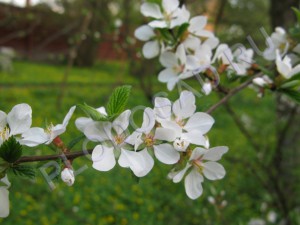 Academician V.P. Tsarenko started the selection of cherry felt in the early 70s. After 10 years, her daughter joined this work. At first, all the gardens of the Far East were examined. The most interesting (including the varieties of G. T. Kazmina) was planted at the experimental station, studied and included in the selection, which means that from year to year, with increasing volume, were crossed, studying the offspring and selection, selection, selection ... Of the more than 3000 hybrid seedlings grown in total, 400 were initially allocated, and of these, a little more than 40, which are now varieties. A deep bow to you, great workers, and to gardeners the wish to open a gate to your garden in these varieties and not to lose them, as is often the case. Fortunately, these varieties are actively propagated and distributed throughout the country by the NPO Garden and Kitchen Garden LLC (Chelyabinsk). And I was lucky - at the 2nd congress of gardeners, which took place in December 2010 in Chelyabinsk, I listened to a report by Natalia Tsarenko, and then she came to my hotel room, and long after midnight she told about the Far East, her mother, her work, two little twin sons. Unforgettably!
Academician V.P. Tsarenko started the selection of cherry felt in the early 70s. After 10 years, her daughter joined this work. At first, all the gardens of the Far East were examined. The most interesting (including the varieties of G. T. Kazmina) was planted at the experimental station, studied and included in the selection, which means that from year to year, with increasing volume, were crossed, studying the offspring and selection, selection, selection ... Of the more than 3000 hybrid seedlings grown in total, 400 were initially allocated, and of these, a little more than 40, which are now varieties. A deep bow to you, great workers, and to gardeners the wish to open a gate to your garden in these varieties and not to lose them, as is often the case. Fortunately, these varieties are actively propagated and distributed throughout the country by the NPO Garden and Kitchen Garden LLC (Chelyabinsk). And I was lucky - at the 2nd congress of gardeners, which took place in December 2010 in Chelyabinsk, I listened to a report by Natalia Tsarenko, and then she came to my hotel room, and long after midnight she told about the Far East, her mother, her work, two little twin sons. Unforgettably!
In the cherry varieties of felt Tsarenko, I was primarily struck by the variety of ripening terms: from very early (fruit ripening July 10 - 15) - Delight, Natalie, Fairy Tale, Children (zoned), Tasty, Early, Fairy, Desire, Sweet, Fairy, Gourmet , Krasnaya, Yield (promising for regionalization), up to varieties with really late maturing (end of July - beginning of August) - Generous, Dream, Cherry, Virovskaya.
Impressive and increase the mass (weight) of the fruit. In almost all varieties, it reaches an average of 3 or more grams, whereas in non-varietal plants it varies only between 0.3 and 1.2 g. The largest fruits are in varieties of Natali (4.0 g), Tsarevna (3 , 6 g), Children's (3.5 g).
 The fruits of varietal felt cherries are distinguished by improved taste, which many of them (Alice, Oriental, Beauty, Natalie, Ocean Virovskaya, Autumn Virovskaya, Tasty, Red, Dream, Fairytale, Generous) are rated at 4 points, whereas, for example, under the same conditions, even Lubskaya and Rastunya’s varieties of cherries have a tasting score of only 3.5 and 3.8 points respectively.
The fruits of varietal felt cherries are distinguished by improved taste, which many of them (Alice, Oriental, Beauty, Natalie, Ocean Virovskaya, Autumn Virovskaya, Tasty, Red, Dream, Fairytale, Generous) are rated at 4 points, whereas, for example, under the same conditions, even Lubskaya and Rastunya’s varieties of cherries have a tasting score of only 3.5 and 3.8 points respectively.
Important in the direction of Tsarenko's selection was the combination of the already mentioned improvements of the fruits with their semi-dry margin. And this, too, in the overwhelming number of varieties succeeded.
Not offended varieties of felt cherries and yield. In the family gardens of the Far East with good care, they give 15 - 20 kg or more per bush.
Among the varieties of Tsarenko there is one absolutely extraordinary - White, which, of course, is so named for the white color of fruits that is rarely seen in plants. The fruits are white and outwardly, they have white flesh, and even a bone - and that white. The taste is sweet and sour, pleasant. This unusual albino was found in one of the amateur gardens near Vladivostok. And if we recall the almost black fruits of the Damanka variety, we can conclude that the color of the fruits of felt cherries can be from white, through varying degrees of brightness to red, to almost black. And yet there are still new and new varieties, new combinations of crosses, something else will be ...
 But, attracting the attention of gardeners to varieties of felt cherries, it is impossible not to say that they, just like its ordinary seedlings, are now beginning to be damaged by two destructive fungal diseases - coccomycosis and monilial burn. Earlier, these diseases, like the plague, collapsed on our ordinary cherries and largely destroyed them. And now they got to cherry felted. In fairness, I will say that so far, in comparison with ordinary cherries, the felt is more sustainable, although it does not have really resistant varieties of these diseases. But collected by scientists of its large gene pool and continuing selection work gives hope that they will be obtained. After all, the selection was saved by the spherotoe (powdery mildew) from the complete destruction of the gooseberry, returned to the gardens in a renewed and expanded form of pear, created scab-resistant apple varieties. In the meantime, plant a felt cherry in your garden, and not just a seedling, but a varietal one. And take care of her care. For example, I have two bushes, and there are fruits, although, of course, not so much as it used to be.
But, attracting the attention of gardeners to varieties of felt cherries, it is impossible not to say that they, just like its ordinary seedlings, are now beginning to be damaged by two destructive fungal diseases - coccomycosis and monilial burn. Earlier, these diseases, like the plague, collapsed on our ordinary cherries and largely destroyed them. And now they got to cherry felted. In fairness, I will say that so far, in comparison with ordinary cherries, the felt is more sustainable, although it does not have really resistant varieties of these diseases. But collected by scientists of its large gene pool and continuing selection work gives hope that they will be obtained. After all, the selection was saved by the spherotoe (powdery mildew) from the complete destruction of the gooseberry, returned to the gardens in a renewed and expanded form of pear, created scab-resistant apple varieties. In the meantime, plant a felt cherry in your garden, and not just a seedling, but a varietal one. And take care of her care. For example, I have two bushes, and there are fruits, although, of course, not so much as it used to be.
We will return the dogwood to the gardens
 Cornel is the most ancient, but unfortunately almost forgotten southern fruit plant. Archaeologists have found his bones during the excavation of settlements dating back to the Neolithic period. It got its name for the red color of the fruit, which means red from Turkic. It can be designated by any of the two species names: cornel, real and male. Now there is practically no cornel in the culture. Neither in the south of Russia, nor in the CIS countries there is a single plantation of it, nor are there any in European countries.
Cornel is the most ancient, but unfortunately almost forgotten southern fruit plant. Archaeologists have found his bones during the excavation of settlements dating back to the Neolithic period. It got its name for the red color of the fruit, which means red from Turkic. It can be designated by any of the two species names: cornel, real and male. Now there is practically no cornel in the culture. Neither in the south of Russia, nor in the CIS countries there is a single plantation of it, nor are there any in European countries.
In Russia, individual dogwood trees (usually large-fruited forms), and then only occasionally, can be found only in family gardens of the North Caucasus and even more rarely - the Lower Volga region.
Return aronia to the gardens
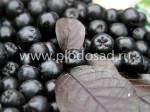 In the people for the blackness of the berries it is called chokeberry. But it is not a mountain ash at all, it belongs to a different genus, and in botany it is known as Aronia. Unlike mountain ash, which grows with a tree, chokeberry is a shrub that resembles a currant, only taller, up to 2.5 m. And its leaves are completely different, whole, round, or rather, ovate, dense, smooth, shiny . That's just the shape of the fruit collected in the same as that of the mountain ash brush, makes it similar to this plant. Aronia fruits contain seeds, and therefore, like apple and pear trees, they belong to pome fruit crops. But due to the fact that aronia is a shrub, it is grown as a berry plant, and it conditionally refers to the berries.
In the people for the blackness of the berries it is called chokeberry. But it is not a mountain ash at all, it belongs to a different genus, and in botany it is known as Aronia. Unlike mountain ash, which grows with a tree, chokeberry is a shrub that resembles a currant, only taller, up to 2.5 m. And its leaves are completely different, whole, round, or rather, ovate, dense, smooth, shiny . That's just the shape of the fruit collected in the same as that of the mountain ash brush, makes it similar to this plant. Aronia fruits contain seeds, and therefore, like apple and pear trees, they belong to pome fruit crops. But due to the fact that aronia is a shrub, it is grown as a berry plant, and it conditionally refers to the berries.
Flat seed (cherry prickly, Chinese princepia)
 The flat seed (other names: cherry prickly, Chinese prisepia) is still a potentially new stone fruit. It is of interest to be introduced into gardens as a cherry-like plant that does not know the devastating diseases of our cherries - coccomycosis and moniliosis. Practically not affected by pests. In addition, the flat seed is winter-hardy, drought-resistant grows fast, has a well-developed root system, and easily tolerates transplanting and pruning.
The flat seed (other names: cherry prickly, Chinese prisepia) is still a potentially new stone fruit. It is of interest to be introduced into gardens as a cherry-like plant that does not know the devastating diseases of our cherries - coccomycosis and moniliosis. Practically not affected by pests. In addition, the flat seed is winter-hardy, drought-resistant grows fast, has a well-developed root system, and easily tolerates transplanting and pruning.
In short, what is not cherry saxaul! It is also important that the fruits of this plant, as compared with cherries (for example, the Vole variety) contain three times more vitamin C and in two - P-active compounds.
This plant was first described by the English botanist Oliver under the name “plagiopermum” in 1886. Later, in 1932, the well-known researcher of vegetation of the Far East, academician P. Komarov attributed this plant to the genus Prinsepia (the genus is named after the American botanist James Prinsep) and gave The species name of the place of growth is Chinese. And because the flat seed is also called prisepii.
A flat seed is a thorny shrub, up to 2 m in height, with very original, long, curved, twig-shaped branches that, like lianas, can move to nearby growing trees. Fruits - globose drupe, slightly flattened laterally (whence the name of the plant), up to 2 cm in diameter, bright red in color, with a large oval-shaped bone. The flesh is juicy, pleasant sweet-sour taste. The fruits ripen in late July, they are quite edible fresh, suitable for processing: jam, jam, juice, compotes, drying. Lack of fruits - too large bone and a relatively small mass of pulp enveloping it.

For the similarity of fruits with cherries and homelessness in life, this plant is called "prickly cherry."
The flat seed is a very ancient plant. Scientists suggest that it existed about 50 million years ago and was the ancestor of other stone fruit of the Rosaceae family. In the wild state is found in China, Korea and here in Primorye. It grows along the banks of rivers in a moist, rich alluvial soil. It is found rarely, usually in separate bushes and only occasionally in small thickets.
Since the end of the XIX century. flat seed is used in ornamental gardening. It looks beautiful in single and group plantings, especially during the period of fruit ripening, effectively contrasting with the green foliage. No less attractive is the flat seed in the fall, with gold-colored foliage. It is also good for hedges, used for securing slopes.
Prisepia blooms with yellow, medium-sized, fragrant flowers, collected in the axils of leaves of 1-4 pieces. In Moscow, it blooms in early May, in the Urals - towards the end of the month. Flowering lasts up to two weeks. Like most of the Far Eastern plants, vegetation begins very early: the leaves on the shrub begin to bloom in early April.
Propagated by seed propagation in open ground fall or spring. For spring sowing, seeds need stratification for four months. It can also be propagated by layering and green cuttings. Plants from seeds bloom in the fourth or fifth year, and by eight years they already produce a decent crop - up to 10 kg per tree.
Like many stone fruits, the flat seed is a self-infertile plant. To obtain stable yields in the garden it is necessary to plant at least two (preferably 4-5) plants. And also pay attention to the fact that although prisepia makes shading, it grows faster and more decorative in a sunny place.
Prinsepia is a rare wild plant and is even listed in the Red Book. Because of the irresponsible behavior of people in nature, it becomes less and less. If we do not have time to enter into the garden, another unique creation of God will disappear from the face of the earth. But, of course, breeders still need to work with it: take away forms with more “fleshy” fruits, remove spines, yes, probably, improve the taste.
Irina Sergeevna Isaeva,
doctor of agricultural sciences

But, does an average summer resident need such plantations?
In this article we will talk about fruit trees that can be planted with your own hands in the middle zone of the Russian Federation and at the same time get a good harvest. In addition, we consider the main points related to the care of such trees.
Choose the best option in accordance with the climate
The fact which trees can be planted in the dacha is influenced by many different factors. But to a greater degree the choice of plants depends on the climatic characteristics of the region. Consider which varieties of plantations are suitable for cultivation in this climate.
Planting fruit trees in the country will be successful if you choose winter-hardy varieties. Winter hardiness is the ability of plantations to tolerate low temperatures without compromising the general condition and without reducing fertility parameters.
In case experience garden work small, we recommend to opt for winter-hardy varieties of plums, pears and apples. Individual varieties of these plantations easily endure the harsh domestic winters.
In addition, the harvest of these trees is easy to dispose of, as it can be used for making preserves, jams, dried fruit compotes and other supplies for the winter.
Determination of parameters of winter hardiness
So, we agreed that the answer to the question of which trees to plant in the country will be winter-hardy varieties.
These trees must have the following qualities:
- resistant to severe frosts in the first half of winter;
- resistance to long-lasting extremely low temperatures in the middle and second half of winter;
- resistance to gradual and severe frosts following the thaw.
Domestic breeders, as a result of the interbreeding of Siberian varieties with mid-Russian and Western European, received beautiful hybrids and individual varieties that demonstrate not only resistance to low temperatures, but also an excellent dessert taste and high yield.
Varieties that can be applied at the dacha
Since the question of which trees are best planted in the country today has not lost its relevance, let us list the fruit trees and their winter-hardy varieties, which can be applied on a country site:
- In climatic conditions characteristic of the Moscow region, the following apple varieties demonstrate increased resistance to low temperatures: Antonovka, Arkadik, Moscow Pear and Cinnamon Striped.
Of the relatively new breeding developments, we mention such varieties as Kitayka Kerr, Candy, Lighthouse Zagorje, Medunitsa, Imrus, Freshness, etc.
Important: Modern breeding developments, in addition to resistance to low temperatures, differ by their adaptability to long-term storage.

On the photo - White filling
Special summer varieties such as Bely filling, Summer striped, Krasa Sverdlovsk, Melba, Papirovka and Uralochka will take root in the climatic conditions characteristic of the Urals and Siberia.

On the photo - Saffron Pepin
Of the autumn varieties, we note the Anis of Sverdlovsk, Pepin saffron, the gift of autumn, the Ural bulk, Wellsi, Sverdlovsk man, and the Northern synapse.
- Among the winter-hardy varieties of pears, we note the following varieties: - these are Cathedral, Lada and Chizhovskaya.

In the photo - late winter hardy pears
Especially for the needs of gardeners of the Urals and Siberia, the following varieties were bred: Beee, Kupava, Lel, Perun and Svarog. These trees withstand frosts down to -40ºС without the need for the use of covering materials.
- Despite the fact that plum is a predominantly heat-loving culture, there are also winter-hardy varieties, planting which can not worry about damage to the crop by frosts during the flowering period.

On the photo - Skorospelka red
These varieties include Alexiy (late-ripening variety), Moscow Hungarian, Zanyatnaya, Kantemirovka, Blue Gift and Skorospelka red.
When deciding which fruit trees to plant in country houses from a container block, it is important to understand that even the most winter-hardy varieties that can withstand temperatures down to -45 ° C do not guarantee a good harvest without proper care.
When to plant
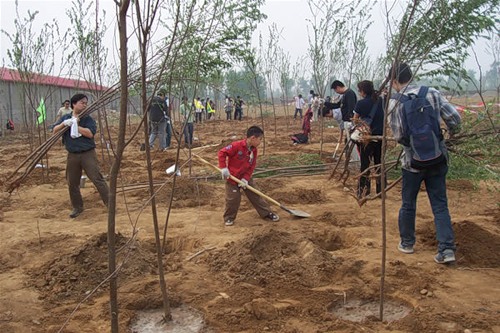
In the photo - spring work in the garden
In order to rely on a good harvest, you need to know when to plant trees in the country. Most gardeners doubt, choosing between autumn and spring planting. Meanwhile, the instruction is simple and directly depends on the type of the root system.
Saplings with an open root system, it is advisable to plant in the fall after the foliage has fallen, but the frost has not come. The trees with an open root system include an apple tree, a pear tree, a plum tree, and a number of seedlings that are not sufficiently resistant to low temperatures.
Saplings are planted in the period from late September to mid-October in pre-prepared pits. With an average daily temperature above + 4 ° C, you can be sure that the seedlings will take root. Planting trees in beds (on the hills) is carried out mainly in spring.
If seedlings are harvested with a closed root system, the trees can be planted in the country in autumn and spring. The fact is that such plantations are less demanding on soil moisture and temperature.
Important: Planting seedlings with foliage should be carried out in cloudy weather or in the evening. Over the next few days on the tree, it is advisable to throw gauze. As long as the seedling does not take root, an excess of sunlight will not benefit.
Regardless of the characteristics of seedlings, from the moment of planting within a few days they must be watered. Over the next month, it will be necessary to follow the soil moisture level.
Tip: To supply water from the well to the site will require an electric pump. And if electricity is not supplied to the suburban area, the purchase or rental of a diesel generator for the dacha will help.
Care features
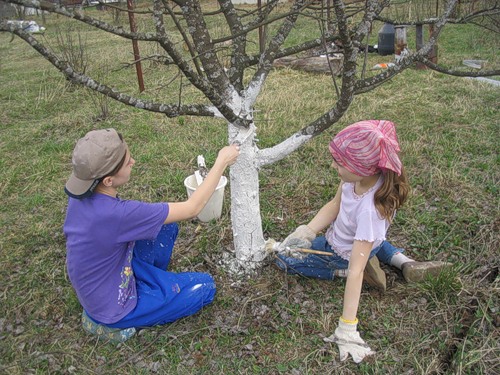
Are you interested in when to whitewash trees in the country? You need to do this in the spring, then when the buds swell. Unfortunately, one whitewash to protect the tree from pests will not succeed.
No less important topic is pruning trees.
It is important to remember that:
- Fruit trees, unlike ornamental plantings, are pruned not to create an attractive shape, but in order for the sun to reach every part of the crown.
- Strongly pruning young trees, you slow down the beginning of their fruiting.
- For greater yields when pruning, you must leave the main branches and trim the secondary processes, claiming to be the top.
- Often pruning a lot of small branches does not provide the effect that guarantees cutting a large branch.
- Trimming branches thicker than 1 cm, the wound needs to be covered with a garden pitch containing heteroauxin. Some gardeners smeared the cut with oil paint. It is not recommended to do this, since such compositions in addition to their toxicity do not contribute to the healing of wounds.
Conclusion
Of course, the price of a good harvest is high and in order to get it you will have to try. But now that you know how to select and grow fruit trees, you will succeed.
If you have any questions, watch the video in this article.
During the acquisition of trees and shrubs in his plot, the owner of the dacha wants to receive from future plants not only practical function in the form of tasty fruits, but also enjoy them appearanceemphasizing the main interior of the backyard territory.
Since such cultures have been growing for many years, their appearance should not be boring and annoying, but attractive and unusual. Of course, it should be understood that in this case we will have to try to ensure timely and regular care of the plants. In addition, taking care of them will help in the autumn season to enjoy a rich harvest.
The most common
In each region of our country, you can find different popular types of beautiful trees and shrubs, bearing fruit, since all areas differ from each other in climatic conditions. However, there are some types of plants that are especially curious to most gardeners, due to which they try to find the most suitable place for such crops on the site. The names of many of these trees and shrubs are familiar even to ordinary people who are never keen on gardening.
The most famous and actively grown in any territory in the holiday villages, of course, are apple trees. They differ from each other not only by variety, but also by the period of fruit ripening. The second place in this rating will be taken by pear trees, and along with them cherry and plum. In shrubs, gardeners pay much attention to raspberries, gooseberries, and currants. Not so long ago, felt cherries, healing sea buckthorn and honeysuckle ripening early, began to gain popularity. Also in the garden of experienced gardeners and gardeners can be found now a blackberry or chokeberry. But this does not mean that other cultures are almost never used. On the contrary, before they were planted only to give the garden a green look for a natural interior, and now they are finding practical application for many such plants.
In fact, it is possible to list trees and shrubs, which are planted in their gardens by the owners of country houses, indefinitely. But it is worth remembering the fact that the first harvest from the orchard should be waited not earlier than five years, although the berry bushes can bear fruit the next year after planting, or another year after its implementation.

The positive features of the shrub include small size and unpretentiousness in terms of care and ensuring certain conditions for their development. But a garden is not a garden if there are no trees in it. Of course, there is a perception that in the northern part of the country the choice of possible plantings is limited by climatic conditions, and in the southern side, on the contrary, the list of cultures is huge and diverse. And this is true, because in such warm countries you can plant cherry plum, apricot, nuts, cherries and much more that will not grow in the North or in a temperate climate. With regard to shrubs, this list can be supplemented with grapes, dogwoods and other crops.
However, varieties of trees and shrubs, which used to grow only in warm climates and southern regions, are now developed, and now they are also available in the central belt. Even in the North, it became possible to grow many southern characteristic plants. Undoubtedly, all gardeners are attracted by the opportunity to organize a real "paradise" on their territory. But many gardeners forget that such crops will require specialized care and competent aspects of cultivation, because in this matter you need to take into account a lot of factors.
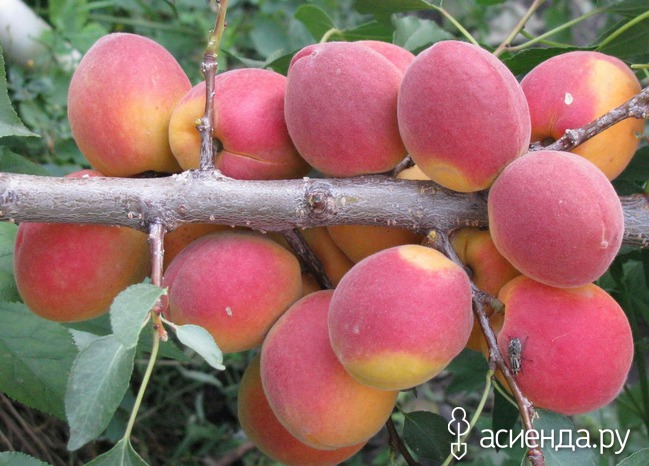
How to place them in the garden?
Young saplings of bushes and trees are pulled out every year in length, and their crowns in a couple of years grow by a distance of one to two meters. Thus, matured plants begin to take up a lot of space and crowd out their neighbors. As a result, it becomes clear that the choice of the most resistant to cold and fruitful varieties is still half the battle, and another huge part of the process is the planning of the future garden.First you need to take a clean white sheet and measure the distance from the areas where the plants will be planted, to other objects - roads, neighboring areas and so on. Not only the aesthetic wishes of the garden owner are important for its attractive appearance. It is necessary to remember which plants get along and fit together, and which do not. On this basis, it is possible to measure the optimal distance of the planting zone from all objects and the plants themselves from each other.


